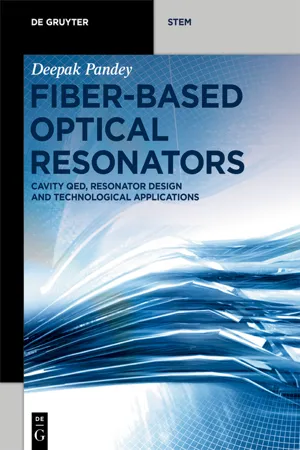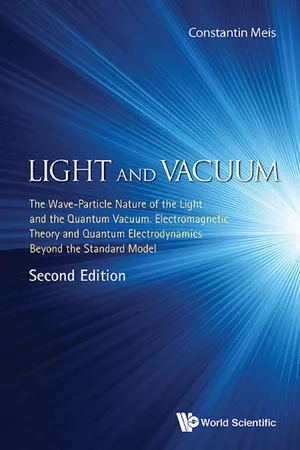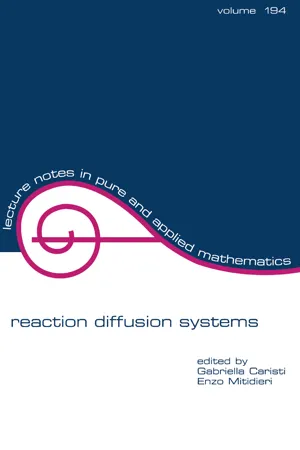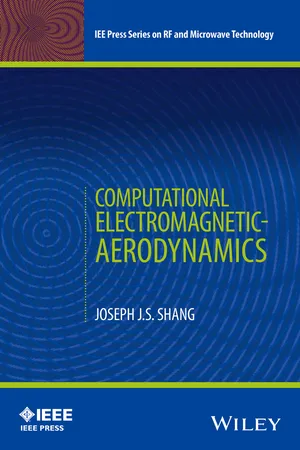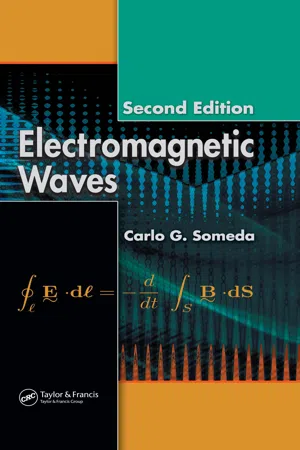Physics
TM Mode
TM mode refers to a type of electromagnetic wave propagation in a waveguide or transmission line, where the electric field is transverse to the direction of propagation and the magnetic field is predominantly in the direction of propagation. This mode is characterized by a cutoff frequency below which it cannot propagate and finds applications in various microwave and optical devices.
Written by Perlego with AI-assistance
Related key terms
Related key terms
1 of 4
Related key terms
1 of 3
6 Key excerpts on "TM Mode"
- eBook - ePub
Fiber-Based Optical Resonators
Cavity QED, Resonator Design and Technological Applications
- Deepak Pandey(Author)
- 2024(Publication Date)
- De Gruyter(Publisher)
A waveguide is a structure or device used to guide and confine electromagnetic waves along a specific path. It is designed to propagate and control the transmission of electromagnetic energy, typically in the form of microwaves or radio waves. Waveguides are commonly used in various fields, including telecommunications, radar systems, microwave engineering, and high-frequency applications. Waveguides are typically constructed as hollow metallic or dielectric tubes, although other shapes and materials can be used depending on the specific requirements. The inner walls of the waveguide are highly reflective to the electromagnetic waves, allowing them to bounce back and forth within the waveguide without significant energy loss. This reflection is often achieved through the principle of total internal reflection, where the waveguide walls act as mirrors for the waves. The main purpose of a waveguide is to provide a controlled pathway for electromagnetic waves, allowing them to be efficiently transmitted, directed, and manipulated. By confining the waves within the waveguide, they can be guided over long distances while minimizing losses due to radiation and external interference. Waveguides support the propagation of different modes, which represent distinct patterns of electric and magnetic fields within the structure. These modes depend on the geometry, dimensions, and boundary conditions of the waveguide. The selection of a specific mode depends on the desired performance and functionality of the waveguide system.Waveguide modes refer to the different possible patterns of electromagnetic wave propagation within a waveguide. The modes of a waveguide are distinct patterns of electric and magnetic fields that can exist within the waveguide. These modes are characterized by their unique field distributions and corresponding propagation characteristics. The number and types of modes depend on the geometry and dimensions of the waveguide. Here are some key concepts related to waveguide modes.TE-modes are electromagnetic wave modes in which the electric field is purely transverse (perpendicular) to the direction of propagation. In these modes, the magnetic field has both transverse and longitudinal components. The subscript “m,n” is used to represent the mode indices, where “m” denotes the number of half-wavelength variations of the electric field across the width of the waveguide, and “n” represents the number of half-wavelength variations along the length.TM-modes are electromagnetic wave modes in which the magnetic field is purely transverse to the direction of propagation. In these modes, the electric field has both transverse and longitudinal components. Similar to TE modes, the mode indices “m,n” are used to represent the variations of the magnetic field across the width and length of the waveguide.Hybrid modes, also known as TE-TM Modes or EH-modes, have both electric and magnetic field components in both transverse and longitudinal directions. These modes possess characteristics of both TE and TM Modes and are generally more complex in nature. - eBook - ePub
- Philip C. Magnusson, Andreas Weisshaar, Vijai K. Tripathi, Gerald C. Alexander(Authors)
- 2017(Publication Date)
- CRC Press(Publisher)
10 mode.In usual applications of rectangular waveguides, transmission in the TE10 mode alone is sought, and the guide dimensions are chosen with respect to frequency so as to ensure this. Hence transverse-magnetic modes will exist only in evanescent form in the vicinity of guide discontinuities.FIGURE 13-4 TMn propagating mode in rectangular waveguide.(2) TE Modes
For general analysis of TE modes one substitutes Eqs. 13-74 and 13-75 in Eq. 13-73 , and that in turn in Eq. 13-63 , so that the E-field components parallel to the guide surfaces may be found:The boundary condition that the tangential components of E vanish along the guide surfaces fixes most of these constants:From Eq. 13-76 ,This is the same as the equation for the phase function of TM Modes, Eq. 13-79 ; Eq. 13-82 for cutoff frequencies of TM Modes is also applicable here for TE modes.Equations 13-79 and 13-84 may be restated in shortened form:The results just found may be combined with Eqs. 13-70 ,13-83,13-73,13-62, and 13-63 to yield expressions for the field components.LetIt should be noted that either m or n (but not both) may be set equal to zero for TE modes and still yield nontrivial results, but that both m and n must be nonzero for TM Modes. Setting n equal to zero reduces the TE solution just given to the form developed in Eqs. 13-8 and 13-9 . TE0n-mode patterns resemble the TEw0 ones, except that they are turned 90° in space (in terms of Fig. 13-1 ) such that the E-field variation takes place in the shorter transverse direction.Except for a square waveguide, the TE10 mode has a lower cutoff frequency than the TE01 mode; in any case it has a lower cutoff frequency than any other TE mode, and, as noted in Sec. 13-4d(2), than any TM Mode. Hence it is properly called the dominant mode.e. Waveguide Characteristic Impedances
- eBook - ePub
Light And Vacuum: The Wave-particle Nature Of The Light And The Quantum Vacuum. Electromagnetic Theory And Quantum Electrodynamics Beyond The Standard Model (Second Edition)
The Wave–Particle Nature of the Light and the Quantum Vacuum. Electromagnetic Theory and Quantum Electrodynamics Beyond the Standard Model
- Constantin Meis(Author)
- 2017(Publication Date)
- WSPC(Publisher)
3.2.26 ) in free space. It is of high interest to explore the way the electromagnetic wave propagate in a waveguide of specific cross sectional shape and dimensions. The problem consists of seeking solutions to Maxwell’s equations satisfying the particular boundary conditions imposed by the waveguide shape.Let us consider the simple case in which the inner walls of the waveguide consists of a homogeneous and isotropic dielectric with fixed values of ε and µ. It is worth noting that a TEM mode can only propagate in the presence of two or more guiding conductors. Consequently, a TEM mode cannot propagate in a hollow waveguide since it is composed of a single conductor. Thus, we give below the components of the electric and magnetic fields of transverse electric (TE) and transverse magnetic (TM) modes satisfying Maxwell’s equations and the boundary conditions, in the case of rectangular and circular waveguides.•Rectangular waveguide of cross section a, b (a > b)We also assume here time-harmonic fields with an angular frequency ω, hence with an exponential dependence eiωt . The propagating fields must be solutions of Maxwell’s equations satisfying the boundary conditions, for the components of the electric and magnetic fields on the waveguide walls.•Rectangular waveguide TEm,n modesAre characterized by the absence of the electric field component along the propagation axis Ez = 0. The magnetic field components Hz has to satisfy the reduced (simplifies the time dependence) propagation equationThe boundary conditions for the electric field tangential components areThe solutions in Cartesian coordinates (x, y, z) are given byWith m, n = 0,1,2,… and where γ is the propagation factorwith k2 = µεω2 andis the cut-off wave vector and λcthe cut-off wavelength corresponding to a cut-off angular frequencyOnly modes with ω > ωc and λ < λccan propagate in this rectangular waveguide. The TE mode with the biggest wavelength (lower frequency) that can propagate in the rectangular wave guide with a > b corresponds to the values m = 1 and n - eBook - ePub
- Gabriela Caristi, Enzo Mitidieri(Authors)
- 2020(Publication Date)
- CRC Press(Publisher)
Opt. Lett. 12 (1987), 187–189.[7 ] Joseph, R. I. and Christodoulides, D. N.: Exact field decomposition for TM waves in nonlinear media, Opt. Lett. 10 (1987), 826–828.[8 ] Ogusu, K.: TM waves guided by nonlinear planar waveguides, IEEE, Trans. Microwave Th. et Tech., 37 (1989), 941–946.[9 ] Chen, Y.: TE and TM families of self-trapped beams, IEEE J. Quantum Elect., 27 (1991), 1236–1241.[10 ] Yokota, M.: Guided transverse-magnetic waves supported by a weakly nonlinear slab waveguide, J. Opt. Soc. Am. B10 (1993), 1096–1101.[11 ] Wang, X. H. and Cambrell, G. Κ.: Full vectorial simulation of bistability phenomena in nonlinear-optical channel wave-guides, J. Opt. Soc. Am. B10 (1993), 1090–1095.[12 ] Wang, X. H. and Cambrell, G. K.: Simulation of strong nonlinear effects in optical waveguides, J. Opt. Soc. Am. Β11 (1993), 2048–2055.[13 ] Leung, Κ. M.: p-polarized nonlinear surface polaritons in materials with intensity-dependent dielectric function, Phy. Rev. B32 (1985), 5093–5101.[14 ] Stuart, C. A.: Self-trapping of an electromagnetic field and bifurcation from the essential spectrum, Arch. Rational ;Mech. Anal., 113 (1991), 65–96.[15 ] Stegeman, G. I.: Nonlinear guided wave optics, in Contemporary nonlinear optics, Edited by G. P. Agrawal and R. W. Boyd, Academic Press, Boston, 1992.[16 ] Akhmanov, R.-V., Khorklov, R. V. & Sukhorukov, A. P.: Self-focusing, self-defocusing and self-modulation of laser beams, in Laser Handbook, edited by F.T. Arecchi & E.O. Schulz Dubois, North-Holland, Amsterdam, 1972.[17 ] Svelto, O.: Self-focusing, self-trapping and self-phase modulation of laser beams, in Progress in Optics, Vol. 12, editor E. Wolf, North-Holland, Amsterdam, 1974.[18 ] Reintjes, J. F.: Nonlinear Optical Processes, in Encyclopedia of Physical Science and Technology, Vol. 9, Academic Press, New York.[19 ] Stegeman, G. I., Ariyant, J., Seaton, C. I., Shen, T.-P. & Moloney, J. V.: Nonlinear thin-film guided waves in non-Kerr media, Appl. Phys. Lett. - eBook - ePub
- Joseph J. S. Shang(Author)
- 2016(Publication Date)
- Wiley-IEEE Press(Publisher)
Both waves in the TE 1,0 and TE 1,1 modes were computed on a (25 × 25 × 197) mesh system at a microwave frequency of 4 GHz. The basic topology of the TE waves are similar; thus, only the result of the TE1,0 is depicted in Figure 5.1. The surface magnetic field is projected on upper surface, and electric surface fields of the electric transverse wave are projected on the vertical and lower surfaces of the waveguide, respectively. For clarity only the far-side wall of the waveguide is shown in this graph. From these numerical results, it is clearly revealed that the electromagnetic wave in the dominant wave is essentially a two-dimensional motion that is displayed in the next few figures. It is interesting to point out that the wave cutoff frequency of the TE 1,1 mode in the rectangular guide is 2.84 GHz (wave number of 1.41 π) in contrast to the lowest cutoff frequency for the TE1,0 wave in the same rectangular guide is 2.42 GHz (wave number of 1.21 π). Figure 5.1 Electromagnetic field structure on waveguide surface. The validation of the computed electrical transverse wave of the TE 1,0 mode is accomplished by comparing with theoretical results; see equation (5.14) in Figure 5.2. The z components of the magnetic field intensity propagating along the waveguide are given versus the value of from 0,0 to 0,1. This parameter actually represents the ratio of the conductive to displacement current that the electromagnetic wave encounters in propagation. For the waveguide simulations, all numerical results are generated on a uniform mesh (25 × 25 × 197) in a square cross-sectional configuration. The aspect ratio between the length and the width is 10, and the electromagnetic wave is propagating at a frequency of 4 GHz. There is no detectable difference between computational and theoretical results in wave profile as it propagates in the dielectric medium. The computational simulations are accurate and show that numerical dispersion and dissipation are negligible - eBook - ePub
- Carlo G. Someda(Author)
- 2017(Publication Date)
- CRC Press(Publisher)
0 , so that nothing changes if the cross-section is short-circuited by means of an ideal electric conductor.C2 Poynting vector
The Poynting vector of the generic TM Mode is given by:P n=e− 2 α n z{ −,12χ n 4j ω ϵ γn|2|∇ tε z−a ^z1j ω ϵ2χ n 2ε z *}∇ tε z( 7.31 )7.31 where again α n = 0 for f ≥ f cn . For its longitudinal and transverse components, refer to Subsection B2.7.4.4 Properties of the TEM mode
D1 Uniqueness of the TEM mode
We saw in Section 7.2 that, when χ 2 = 0, the field must be TEM in order not to give inconsistent relationships. Now let us show also that the inverse is true, namely that a field can be TEM only for χ 2 = 0. In fact, for χ 2 ≠ 0, Eqs. (7.4 ) show that if we setɛz= 0, , then we necessarily haveɛi= 0, , i.e., the trivial solution of Maxwell’s equations in a region without sources. Therefore the eigenvalue corresponding to a TEM field is unique . For this reason we speak of the TEM mode.D2 Existence of the TEM mode
The TEM mode may exist only in cylindrical structures where the cross-section of the dielectric is not a simply connected domain . Indeed, we saw that the TEM field satisfies Eq. (7.15 ):7.32 which is the Laplace equation. A well-known theorem ensures the uniqueness of its solution, when the values of either or are known over the whole contour. Suppose that the border, ℓ, consists of only one ideal conductor, where E tan = 0. Then, elaborating on Eqs. (7.12 ) one may show that this assumption implies on ℓ and on ℓ. These conditions are compatible with a field identically zero everywhere. Because of the uniqueness theorem that we have just quoted, the vanishing field is the solution of the problem. In conclusion, the TEM field cannot exist if the cross-section is a simply connected domain. Examples of non-simply connected regions of practical interest are two-wire lines and coaxial cables. The latter will be studied in this chapter. Most of the contents of the following chapter apply to both. One section in the next chapter will be devoted to striplines
Index pages curate the most relevant extracts from our library of academic textbooks. They’ve been created using an in-house natural language model (NLM), each adding context and meaning to key research topics.
Explore more topic indexes
Explore more topic indexes
1 of 6
Explore more topic indexes
1 of 4
